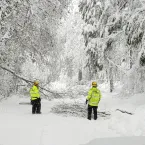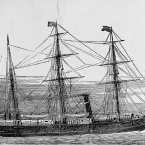
NOAA@NSIDC
Stewards of data, past and present
In this section
Learn how NOAA@NSIDC data are being used in research, and read updates and spotlights on how you can use the data, tools and resources we offer. If you are using NOAA@NSIDC data in your research, teaching or some other way, let us know and we may feature your work in our next article. Share your story with us today.
News & Stories
Filter by:

The NSIDC DAAC and NOAA@NSIDC archive and distribute data sets relevant to maritime navigation in the polar regions. Although they are not up-to-the-minute products for operational navigation, they provide climatological data for planning, risk assessments, and feasibility studies.

A new study focuses on improving global temperature data sets in light of uneven warming across the globe. To fill gaps in historical climate records, the study relies in part on sea ice data from the National Oceanic and Atmospheric Administration program at the National Snow and Ice Data Center (NOAA@NSIDC).

Several representatives from NSIDC will be attending the American Geophysical Union (AGU) Annual Meeting 2024, either virtually or in person in Washington DC, to share their expertise in data management and research in the cryospheric sciences and

Ann Windnagel is a project manager at NSIDC. Her contributions span data set development, interactive applications, and research related to glaciers, sea ice, and snow. In this Q&A, she describes the many hats she has worn over the years, her biggest challenges, and her biggest rewards.

The 2023 winter brought record snowfall to California and other parts of the western United States, but unlike rain, snowfall is much more nuanced in its properties. Getting accurate snow depth data over a wide area is not easy. Read more about the challenges of garnering snow data and the tools behind snow data.

In July 1879, the USS Jeannette left port in San Francisco en route to the North Pole. What lay at the top of the world was still shrouded in mystery. Was it a warm inland sea, a sheet of ice, or open ocean? The crew set out to find out. The majority of the crew of the USS Jeannette perished during the journey, but their memory lives on through the invaluable scientific information that they laboriously collected and returned to civilization.